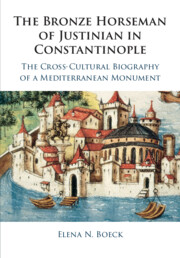 The Bronze Horseman of Justinian in Constantinople
The Bronze Horseman of Justinian in Constantinople Published online by Cambridge University Press: 08 April 2021
This book explores seminal moments in the biography of a contested medieval monument between ca. 500 CE and 1600 CE. Justinian’s triumphal column was the tallest, freestanding column of the pre-modern world and was crowned by the largest metal, equestrian sculpture created anywhere in the world before 1699. This book demonstrates that the colossal, the exceptional, and the stationary can contribute to our understanding of a global middle ages. The monument’s reach was as wide as possible for any stationary object. In order to explore the monument’s changing discursive signification across centuries and cultures, I draw upon anthropological approaches. These analyze an object’s changing valuations within a broader cultural and societal framework from the moment of its creation to the end of its existence. Any moment of substantial human engagement with an object can define a period in its biography. This study is also devoted to the horseman’s agency. Although it may seem peculiar that an inanimate object could possess agency, both medieval observers and modern anthropological studies of material culture urge us to take this notion seriously. Medieval observers fervently believed that the horseman acted.
To save this book to your Kindle, first ensure [email protected] is added to your Approved Personal Document E-mail List under your Personal Document Settings on the Manage Your Content and Devices page of your Amazon account. Then enter the ‘name’ part of your Kindle email address below. Find out more about saving to your Kindle.
Note you can select to save to either the @free.kindle.com or @kindle.com variations. ‘@free.kindle.com’ emails are free but can only be saved to your device when it is connected to wi-fi. ‘@kindle.com’ emails can be delivered even when you are not connected to wi-fi, but note that service fees apply.
Find out more about the Kindle Personal Document Service.
To save content items to your account, please confirm that you agree to abide by our usage policies. If this is the first time you use this feature, you will be asked to authorise Cambridge Core to connect with your account. Find out more about saving content to Dropbox.
To save content items to your account, please confirm that you agree to abide by our usage policies. If this is the first time you use this feature, you will be asked to authorise Cambridge Core to connect with your account. Find out more about saving content to Google Drive.